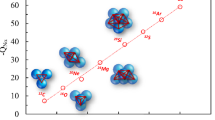Abstract.
A recently introduced relativistic nuclear energy density functional, constrained by features of low-energy QCD, is extended to describe the structure of hypernuclei. The density-dependent mean field and the spin-orbit potential of a Λ-hyperon in a nucleus, are consistently calculated using the SU(3) extension of in-medium chiral perturbation theory. The leading long-range ΛN interaction arises from kaon-exchange and 2π-exchange with a Σ-hyperon in the intermediate state. Scalar and vector mean fields, originating from in-medium changes of the quark condensates, produce a sizeable short-range spin-orbit interaction. The model, when applied to oxygen as a test case, provides a natural explanation for the smallness of the effective Λ spin-orbit potential: an almost complete cancellation between the background contributions (scalar and vector) and the long-range terms generated by two-pion exchange.
Similar content being viewed by others
References
M. Danysz, J. Pniewski, Phil. Mag. 44, 348 (1953)
R.E. Chrien, C.B. Dover, Ann. Rev. Nucl. Part. Sci. 39, 113 (1989)
H. Bando, T. Motoba, J. Zofka, Int. J. Mod. Phys. A 5, 4021 (1990)
D.J. Millener, C.B. Dover, A. Gal, Phys. Rev. C 38, 2700 (1988)
O. Hashimoto, H. Tamura, Prog. Part. Nucl. Phys. 57, 564 (2006) and references therein
H. Kohri et al., AGS-E929 Collaboration, Phys. Rev. C 65, 034607 (2002)
N. Kaiser, S. Fritsch, W. Weise, Nucl. Phys. A 697, 255 (2002)
S. Fritsch, N. Kaiser, W. Weise, Nucl. Phys. A 750, 259 (2005)
P. Finelli, N. Kaiser, D. Vretenar, W. Weise, Nucl. Phys. A 735, 449 (2004)
P. Finelli, N. Kaiser, D. Vretenar, W. Weise, Nucl. Phys. A 770, 1 (2006)
T.D. Cohen, R.J. Furnstahl, D.K. Griegel, X.m. Jin, Prog. Part. Nucl. Phys. 35, 221 (1995)
R.J. Furnstahl, J.J. Rusnak, B.D. Serot, Nucl. Phys. A 632, 607 (1998) [arXiv:nucl-th/9709064]
R.J. Furnstahl, B.D. Serot, Nucl. Phys. A 673, 298 (2000) [arXiv:nucl-th/9912048]
D. Vretenar, A.V. Afanasjev, G.A. Lalazissis, P. Ring, Phys. Rep. 409, 101 (2005)
From relativistic mean-field phenomenology [12-14] it is well known that nucleons in the nuclear medium experience large scalar (ΣS) and vector (ΣV0) self-energies. The nuclear spin-orbit potential naturally results from their coherent action (they nearly cancel in the central potential): \(V_{ls}=\frac{1}{4\bar{M}^2} \left[\frac{1}{r} \frac{d}{dr} (\Sigma_V^0 - \Sigma_S) \right] {\bf \sigma} \cdot {\bf L}\) with \(\bar{M}=M - (1/2)(\Sigma_V^0-\Sigma_S)\). On the other hand, in Ref. [26] it has been shown that contact terms at next-to-leading order (four terms with two derivatives, see Eq. (5) in Ref. [26]) also generate a large spin-orbit interaction \(iC_5 ({\bf \sigma}_1 + {\bf \sigma}_2) \cdot ({\bf q} \times {\bf q}'),\) where the parameter C5 is given by a linear combination of P-wave low-energy constants: \(C_5=\frac{1}{16\pi} [ 2C(^3P_0) + 3C(^3P_1) -5 C(^3P_2)] \;.\) Apparently, it seems difficult to reconcile these two very different mechanisms of spin-orbit generation, but recently the necessary connection has been established [27]. Plohl et al. showed that, at the tree level, large ΣS and ΣV0 are consistently generated by contact terms which occur precisely at next-to-leading order in the chiral expansion. This assertion appears to be rather robust even if one performs a more sophisticated many-body calculation (i.e. DBHF). Including condensate background fields does not spoil the consistency of in-medium chiral calculations based on the leading order πN Lagrangian.
R. Brockmann, W. Weise, Phys. Lett. B 69, 167 (1977); Nucl. Phys. A 355, 365 (1981)
N. Kaiser, W. Weise, Phys. Rev. C 71, 015203 (2005)
P. Finelli, N. Kaiser, D. Vretenar, W. Weise, Phys. Lett. B [arXiv:0707.3389] [nucl-th] (submitted)
B.D. Serot, J.D. Walecka, Int. J. Mod. Phys. E 6, 515 (1997); R.J. Furnstahl, Lect. Notes Phys. 641, 1 (2004)
C. Fuchs, H. Lenske, H.H. Wolter, Phys. Rev. C 52, 3043 (1995)
H.J. Pirner, Phys. Lett. B 85, 190 (1979); J.V. Noble, Phys. Lett. B 89, 325 (1980); B.K. Jennings, Phys. Lett. B 246, 325 (1990)
X.M. Jin, R.J. Furnstahl, Phys. Rev. C 49, 1190 (1994)
E. Chabanat, P. Bonche, P. Haensel, J. Meyer, R. Schaeffer, Nucl. Phys. A 635, 231 (1998)
N. Kaiser, S. Fritsch, W. Weise, Nucl. Phys. A 724, 47 (2003) [arXiv:nucl-th/0212049]
N. Kaiser, Phys. Rev. C 68, 054001 (2003) [arXiv:nucl-th/0312058]
N. Kaiser, Phys. Rev. C 70, 034307 (2004) [arXiv:nucl-th/0407116]
O. Plohl, C. Fuchs, Phys. Rev. C 74, 034325 (2006)
Author information
Authors and Affiliations
Corresponding author
Rights and permissions
About this article
Cite this article
Finelli, P. Hypernuclei and in-medium chiral dynamics . Eur. Phys. J. Spec. Top. 156, 183–190 (2008). https://doi.org/10.1140/epjst/e2008-00615-1
Issue Date:
DOI: https://doi.org/10.1140/epjst/e2008-00615-1




